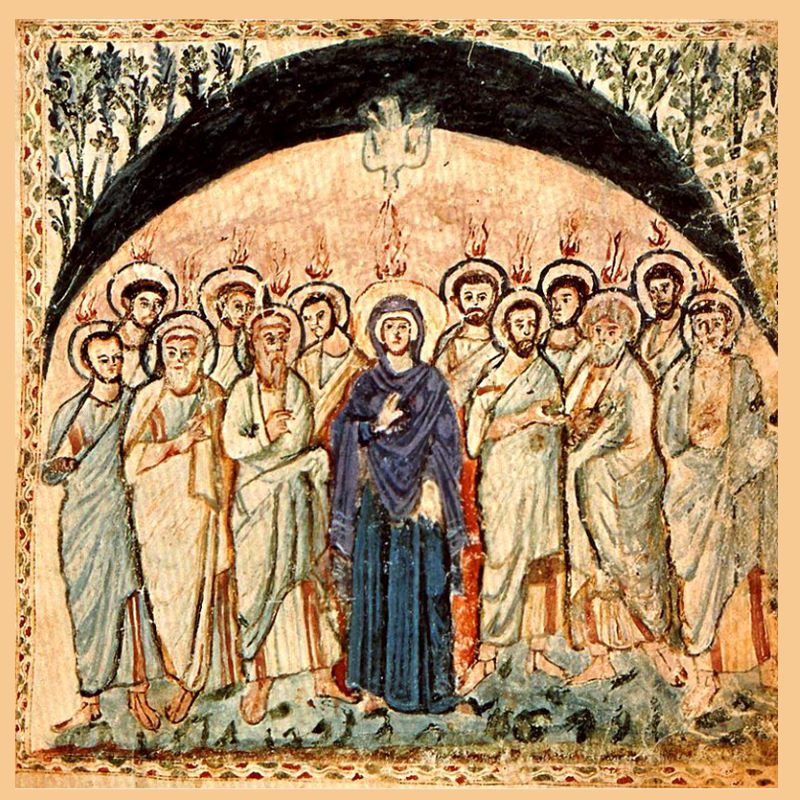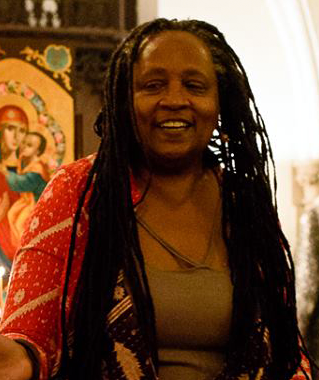In my New Calendarist tradition, last Wednesday was the Feast of Mid-Pentecost, the 25th day after Pascha and before Pentecost. The Pentecost season lasts six weeks. The first three Sundays celebrate Pascha itself–the Resurrection, the Sunday Of St Thomas who confirmed that Jesus himself was the One who died on the cross and came back to them by asking to touch the wounds; and finally, the Sunday of the Myrrhbearers, those courageous women who left home before dawn to tend to Jesus’s body and found an angel who told them the Good News of the Resurrection, and so they were the first to know.
This Mid-Pentecost festival is a day to contemplate the days that have passed and look forward to the coming Sundays. They are Sundays that show us Jesus as a healer and his revelation as the messiah: the Sunday Healing of the Paralytic, the Sunday of the Samaritan Woman, and the Sunday of the restoration of sight to the Man who was blind from birth. And then comes Pentecost, the Coming of the Holy Spirit.
We can follow Mary as she experiences the life of her son as we celebrate as Mid-Pentecost and Pentecost. The icons tell the story.
This Russian icon for Mid-Pentecost from Mstera circa 1800 illuminates the Scripture passage from Luke. It starts when Jesus is found teaching in the Temple. The Holy Family had traveled to Jerusalem to celebrate the Passover. Jesus is a boy of twelve. On the way home, Mary and Joseph realize that Jesus is not with them. They return to Jerusalem and look for him over three days. In Luke 2: 42-52, they find him in the Temple, “sitting among the teachers, listening to them and asking them questions. And all who heard him were amazed at his understanding and his answers.
“Now every year, his parents went to Jerusalem for the festival of the Passover. And when he was twelve, they went up as usual for the festival. When the festival ended, and they started to return, the boy Jesus stayed behind in Jerusalem, but his parents did not know it. Assuming that he was in a group of travelers, they went a day's journey away. Then they started to look for him among their relatives and friends. When they did not find him, they returned to Jerusalem to search for him. After three days, they found him in the temple, sitting among the teachers, listening to them and asking them questions. And all who heard him were amazed at his understanding and his answers. When his parents saw him, they were astonished. His mother said to him, ‘Child, why have you treated us like this? Look, your father and I have been searching for you in great anxiety.’ He said to them, ‘Why were you searching for me? Did you not know that I must be in my Father's house?’ But they did not understand what he said to them. Then he went down with them and came to Nazareth, and was obedient to them. His mother treasured all these things in her heart. And Jesus increased in wisdom and in years, and in divine and human favor.”
The icon shows Jesus in the middle of the image sitting on an elaborately draped and scrolled raised chair. His feet are on a matching footstool. The background architecture suggests the Temple building. Although Jesus is a boy with youthful features, he is larger than the men around him. He holds an open book on his lap, a large book, and he looks down and to his left at the men before him. All of them hold scrolls or books. They are bearded, dressed in fine robes, looking at Jesus or each other. From the gestures and expressions of Jesus and the men around him, we ascertain an intense interaction regarding Scripture.
Standing on Jesus’s right are Mary and Joseph, gazing at their son, reaching out to him with their hands. They appear to be silent, their heads bowed slightly in wonder.
Mary ponders:
Here is my son, this young boy, the one foretold by Gabriel. His spirit and talents are more than I could have ever imagined. I thought we’d lost him. I was frantic with worry. How can I lose my child? What’s happened to him in these crowded streets, these mobs of people traveling through, people buying and selling in the markets, beggars crying for alms, the noise of people shouting and animals bleating and screeching, smells of fires and waste and human sweat. We looked in the doorways and peered into stalls, narrow alleys, and corners. We asked passersby, but there were so many children. How can anyone remember mine? How would they know him? He is my light and my life, sent from God, a little boy so like the others and yet so different. How much I love him, but how do I raise him, how do I teach him, how do I know what he needs, how do I speak to him. ? I am his mother, but he seems so much more than my child. There are depths of wisdom and mystery in him that I do not understand, there are mysteries within him, and I am stunned and awed. Now he’s gone.
But wait. There he is in the Temple, holding the attention of priests and elders, men far beyond his age, steeped in knowledge and trained in discourse. He looks so grand, and they show him such respect. When we tell him how worried we are, he asks, “Why did you seek Me? Did you not know that I must be about My Father’s business?”
My heart breaks. Is it time for him to leave our home and make his way in the world? Surely it’s too soon. Is my work done? Was I enough? Is there nothing more I need to give him?
And then I am consoled. He said, “My Father’s business.”
He knows his father to be within him, filling him with light and wisdom. My son, the Son of God, who speaks with such authority and insight, came to live in me, as Gabriel foretold. I brought you into the world to be God’s Word on earth. Are you closer to Him than I am? Are you closer to Him than you are to me? I brought you here at God’s bidding and will surrender you to God’s will. It will be holy, sweet, and very sad for me to give you away. You were within me as God, and you are on your way beyond me to your Father.
In this Russian icon of Pentecost, which has “Descent of the Holy Spirit” in the inscription, Christ has died, Christ is risen, and the Holy Spirit is sent to us as the Comforter at Pentecost. The arrangement of the figures is similar to the icon above. This time we are not in the Temple but in a space framed by walls and open to the sky where we see a fiery red sun. Mary occupies the central area, and she sits on pillows on a wooden chair with her feet resting on a wooden footstool. Her hands are raised above her lap in signs of blessing. Twelve men, the apostles, surround her and look to her and each other. The flames above their heads symbolize the Holy Spirit. An open book next to a scroll is on a small table in front of Mary.

Mary ponders:
He is gone now, gone forever from this earth and raised to Heaven. Now we receive the Holy Spirit just as he promised. Though it comes in winds and flames, the power and ferocity of the elements, this is the Comforter who will be with us always. We are together. His friends and followers are here. The women who followed him believed and supported him are near us. We promised to care for each other, to love each other as he loved us. I’ve said my final goodbyes to my son, and now he is with his Father, and I feel deep sorrow as I long for his grace, warmth, wisdom, and humanity. His was a difficult and glorious life. He tried so hard for us to understand. Through his healings and teachings, we saw glimpses of the Kingdom. Then it was time for Jesus to go. The troubles he faced, the condemnation and betrayals, the agony on the Cross, are gone for him.
But He told us that the kingdom is among us, his love is with us, his strength, spirit, and truth. All of us are here now, touched by the flame of the Holy Spirit.
Through my sorrow, I am filled with the Holy Spirit. I am here with those who believe, and we are to tell others, tell all people, about his work, his words, and the promise of eternal life. My child has left me, but he will be with me forever in my heart and our work.
(The final icon is from the Rabula Gospels.)
Judith Scott is Axia's spiritual advisor.



